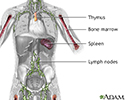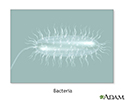Lymphadenitis
Lymph node infection; Lymph gland infection; Localized lymphadenopathyLymphadenitis is an infection of the lymph nodes (also called lymph glands). It is a complication of certain bacterial infections.
Lymph nodes
Lymph nodes are present throughout your body. They are an important part of your immune system. Lymph nodes help your body recognize and fight germ...

Causes
The lymph system (lymphatics) is a network of lymph nodes, lymph ducts, lymph vessels, and organs that produce and move a fluid called lymph from tissues to the bloodstream.
Lymph system
The lymph system is a network of organs, lymph nodes, lymph ducts, and lymph vessels that make and move lymph from tissues to the bloodstream. The l...

The lymph glands, or lymph nodes, are small structures that filter the lymph fluid. There are many white blood cells in the lymph nodes to help fight infection.
Lymphadenitis occurs when the glands become enlarged by swelling (inflammation), often in response to bacteria, viruses, or fungi. The swollen glands are usually found near the site of an infection, tumor, or inflammation.
Lymphadenitis may occur after skin infections or other infections caused by bacteria such as Streptococcus or Staphylococcus. Sometimes, it is caused by rare infections such as tuberculosis or cat scratch disease (Bartonella).
Cat scratch disease
Cat-scratch disease is an infection with bartonella bacteria. It is transmitted by cat scratches, cat bites, or flea bites.

Symptoms
Symptoms may include:
- Red, tender skin over lymph node
- Swollen, tender, or hard lymph nodes
- Fever
Lymph nodes may feel rubbery if an abscess (pocket of pus) has formed or they have become inflamed.
Abscess
An abscess is a collection of pus in any part of the body. In most cases, the area around an abscess is swollen and inflamed.

Exams and Tests
Your health care provider will perform a physical exam. This includes feeling your lymph nodes and looking for signs of injury or infection around any swollen lymph nodes.
A biopsy and culture of the affected area or node may reveal the cause of the inflammation. Blood cultures may reveal spread of infection (often bacteria) to the bloodstream.
Biopsy
A biopsy is the removal of a small piece of tissue for lab examination.

Blood cultures
A blood culture is a laboratory test to check for bacteria or other germs in a blood sample.

Treatment
Lymphadenitis may spread within hours. Treatment should begin right away.
Treatment may include:
- Antibiotics to treat any bacterial infection
-
Analgesics (painkillers) to control pain
Analgesics
Over-the-counter (OTC) pain relievers can help relieve pain or lower a fever. Over-the-counter means you can buy these medicines without a prescript...
 ImageRead Article Now Book Mark Article
ImageRead Article Now Book Mark Article - Anti-inflammatory medicines to reduce inflammation
- Cool compresses to reduce inflammation and pain
Surgery may be needed to drain an abscess.
Outlook (Prognosis)
Prompt treatment with antibiotics usually leads to a complete recovery. It may take weeks, or even months, for swelling to disappear.
Possible Complications
Untreated lymphadenitis may lead to:
- Abscess formation
-
Cellulitis (a skin infection)
Cellulitis
Cellulitis is a common skin infection caused by bacteria. It affects the middle layer of the skin (dermis) and the tissues below. Sometimes, muscle...
 ImageRead Article Now Book Mark Article
ImageRead Article Now Book Mark Article -
Fistulas (seen in lymphadenitis that is due to tuberculosis)
Fistulas
A fistula is an abnormal connection between two body parts, such as an organ or blood vessel and another structure. Fistulas are usually the result ...
 ImageRead Article Now Book Mark Article
ImageRead Article Now Book Mark Article -
Sepsis (bloodstream infection), which can lead to death
Sepsis
Sepsis is an illness in which the body has a severe, inflammatory response to bacteria or other germs.
 ImageRead Article Now Book Mark Article
ImageRead Article Now Book Mark Article
When to Contact a Medical Professional
Contact your provider or go to the emergency room if you have symptoms of lymphadenitis.
Prevention
Good general health and hygiene are helpful in the prevention of any infection.
References
Karan A, Pasternack MS. Lymphadenitis and lymphangitis. In: Blaser MJ, Cohen JI, Holland SM, et al, eds. Mandell, Douglas, and Bennett's Principles and Practice of Infectious Diseases. 10th ed. Philadelphia, PA: Elsevier; 2026:chap 97.
Liu C, Shopsin B, Chambers HF. Staphylococcal infections. In: Goldman L, Cooney KA, eds. Goldman-Cecil Medicine. 27th ed. Philadelphia, PA: Elsevier; 2024:chap 267.
Stevens DL, Bisno AL, Chambers HF; Infectious Diseases Society of America, et al. Practice guidelines for the diagnosis and management of skin and soft tissue infections: 2014 update by the Infectious Diseases Society of America. Clin Infect Dis. 2014;59(2):e10-e52. Erratum in: Clin Infect Dis. 2015;60(9):1448. Dosage error in article text. PMID: 24973422 pubmed.ncbi.nlm.nih.gov/24973422/.
Stevens DL, Bryant AE, Hagman MM. Nonpneumococcal streptococcal infections and rheumatic fever. In: Goldman L, Cooney KA, eds. Goldman-Cecil Medicine. 27th ed. Philadelphia, PA: Elsevier; 2024:chap 269.
-
Lymphatic system - illustration
The lymphatic system filters fluid from around cells. It is an important part of the immune system. When people refer to swollen glands in the neck, they are usually referring to swollen lymph nodes. Common areas where lymph nodes can be easily felt, especially if they are enlarged, are the groin, armpits (axilla), above the clavicle (supraclavicular), in the neck (cervical), and the back of the head just above hairline (occipital).
Lymphatic system
illustration
-
Swollen lymph node - illustration
Lymph nodes play an important part in the body's defense against infection. Swelling might occur even if the infection is trivial or not apparent. Swelling of lymph nodes generally results from localized or systemic infection, abscess formation, or malignancy.
Swollen lymph node
illustration
-
Immune system structures - illustration
The immune system protects the body from potentially harmful substances. The inflammatory response (inflammation) is part of innate immunity. It occurs when tissues are injured by bacteria, trauma, toxins, heat or any other cause.
Immune system structures
illustration
-
Bacteria - illustration
Bacterial infections can lead to the formation of pus, or to the spread of the bacteria in the blood.
Bacteria
illustration
-
Lymphatic system - illustration
The lymphatic system filters fluid from around cells. It is an important part of the immune system. When people refer to swollen glands in the neck, they are usually referring to swollen lymph nodes. Common areas where lymph nodes can be easily felt, especially if they are enlarged, are the groin, armpits (axilla), above the clavicle (supraclavicular), in the neck (cervical), and the back of the head just above hairline (occipital).
Lymphatic system
illustration
-
Swollen lymph node - illustration
Lymph nodes play an important part in the body's defense against infection. Swelling might occur even if the infection is trivial or not apparent. Swelling of lymph nodes generally results from localized or systemic infection, abscess formation, or malignancy.
Swollen lymph node
illustration
-
Immune system structures - illustration
The immune system protects the body from potentially harmful substances. The inflammatory response (inflammation) is part of innate immunity. It occurs when tissues are injured by bacteria, trauma, toxins, heat or any other cause.
Immune system structures
illustration
-
Bacteria - illustration
Bacterial infections can lead to the formation of pus, or to the spread of the bacteria in the blood.
Bacteria
illustration
Review Date: 5/12/2025
Reviewed By: Jatin M. Vyas, MD, PhD, Roy and Diana Vagelos Professor in Medicine, Columbia University Vagelos College of Physicians and Surgeons, Division of Infectious Diseases, Department of Medicine, New York, NY. Also reviewed by David C. Dugdale, MD, Medical Director, Brenda Conaway, Editorial Director, and the A.D.A.M. Editorial team.





